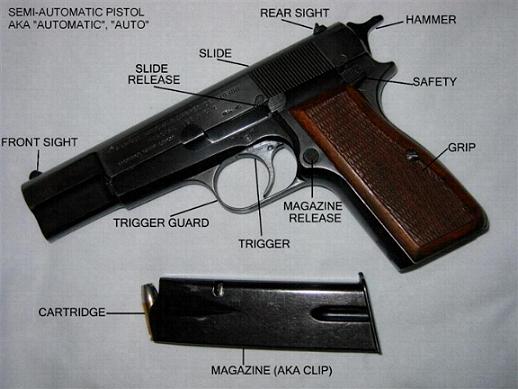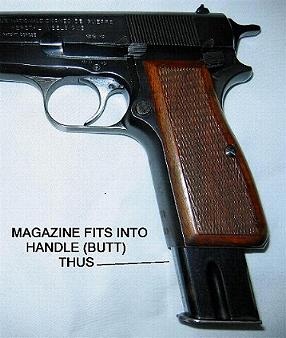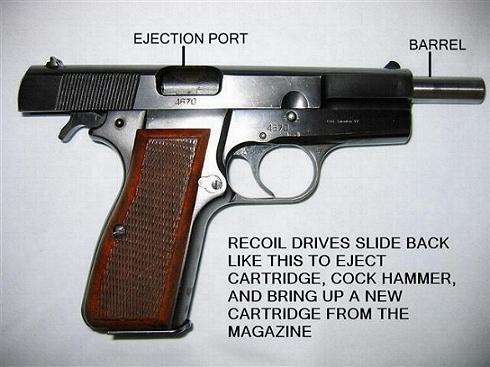 |
Revolvers |
Semi-Automatic |
Ammunition
There are two basic
types of handguns, the
Revolver and the Semi-Automatic (aka
autoloader).

Sometimes the semi-automatic is called an
"automatic", but strictly
speaking, only "semi-automatic" or
"semi-auto" is correct since "automatic"
properly refers only to firearms that can
fire continuously when the trigger is
pulled. These are typically referred to as
machine guns. However, "automatic"
is very often used, correctly or
not, even by knowledgeable firearms users.
In fact the longer, more proper term is not
very widely used by the sort of people who
actually use handguns routinely such as
police and criminals. Personally I call them
autoloaders and use the term "auto".
Just to save myself a bit of typing, I will
use "auto" to refer to the semi-automatic
aka autoloading pistol.
An auto has only one chamber, which is an
integral part of the barrel. It has no
cylinder, and therefore cannot be mistaken
for a revolver.
(Click
HERE
for information about ammunition).
Instead, the cartridges are loaded into a
metal magazine or clip
(technically "magazine" is correct, but
"clip" is more commonly used). This
magazine is
then inserted into the butt of the pistol.
The magazine contains a spring, that pushes the
cartridges upward for feeding into the
chamber.

When the auto is fired, the force of the
recoil is used to drive back the slide.
As the slide moves backward, the empty
cartridge case is extracted from the chamber
and thrown out through the ejector port.
The rearward force of the slide also cocks
the hammer.

(Some autos such as the Glock and
Springfield XD do not have hammers, but use a
spring-loaded firing pin, like a rifle. The
basic principle is still the same.)
Next the slide is pushed forward by the
pressure of a powerful spring. As it moves
forward, it picks up the top cartridge in
the magazine and pushes it into the chamber.
Depending on the power of the auto, it may
also be locked into place by some mechanism.
Once the slide stops moving, the pistol is
ready to fire.
At this point the hammer (or firing pin) is cocked; a
simple pressure on the trigger will cause
the pistol to go off. When cocked, autos
require very little finger pressure on the
trigger (typically about 5 pounds). For this reason, most
autos of older design do have safety
mechanisms of some sort.
In recent years the trend has been toward
auto pistols that do not cock themselves in
this way, but have to be fired
double-action, like a revolver or have a
firing pin mechanism.
Here is a video of how to load an
autoloader.
How to Load a Semi-Automatic Handgun
Revolvers |
Semi-Automatic |
Ammunition
|
 |